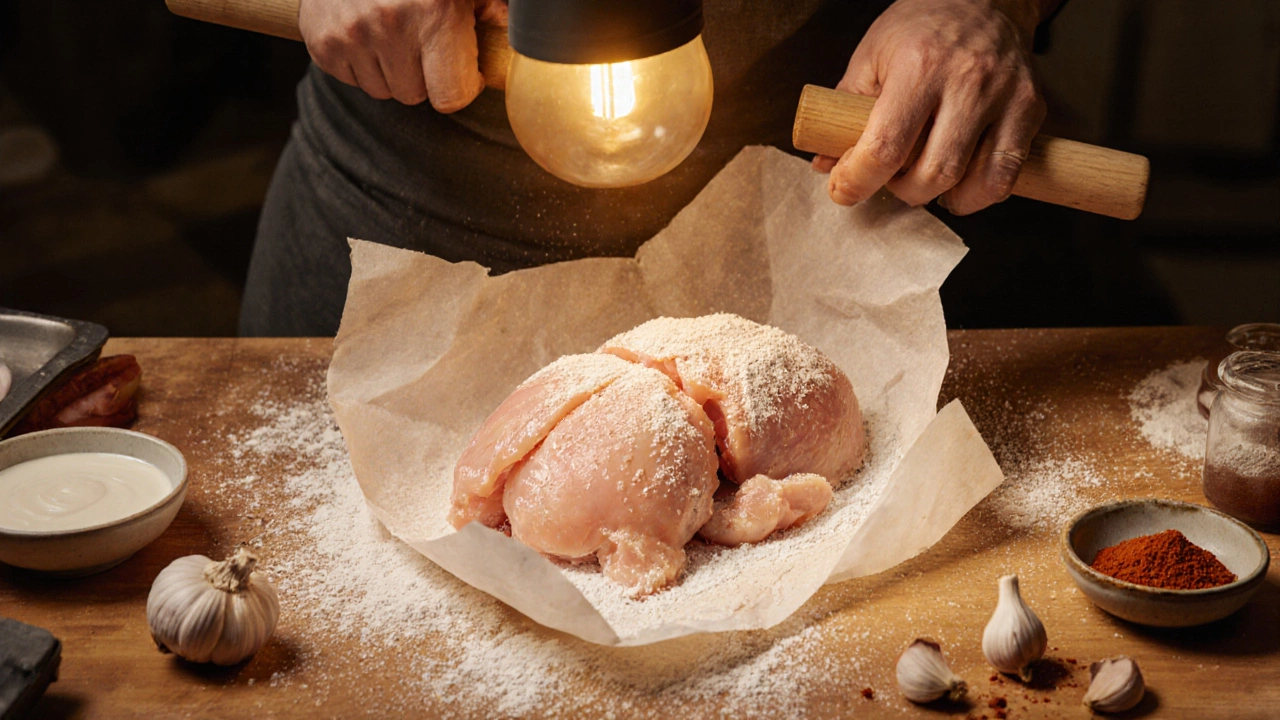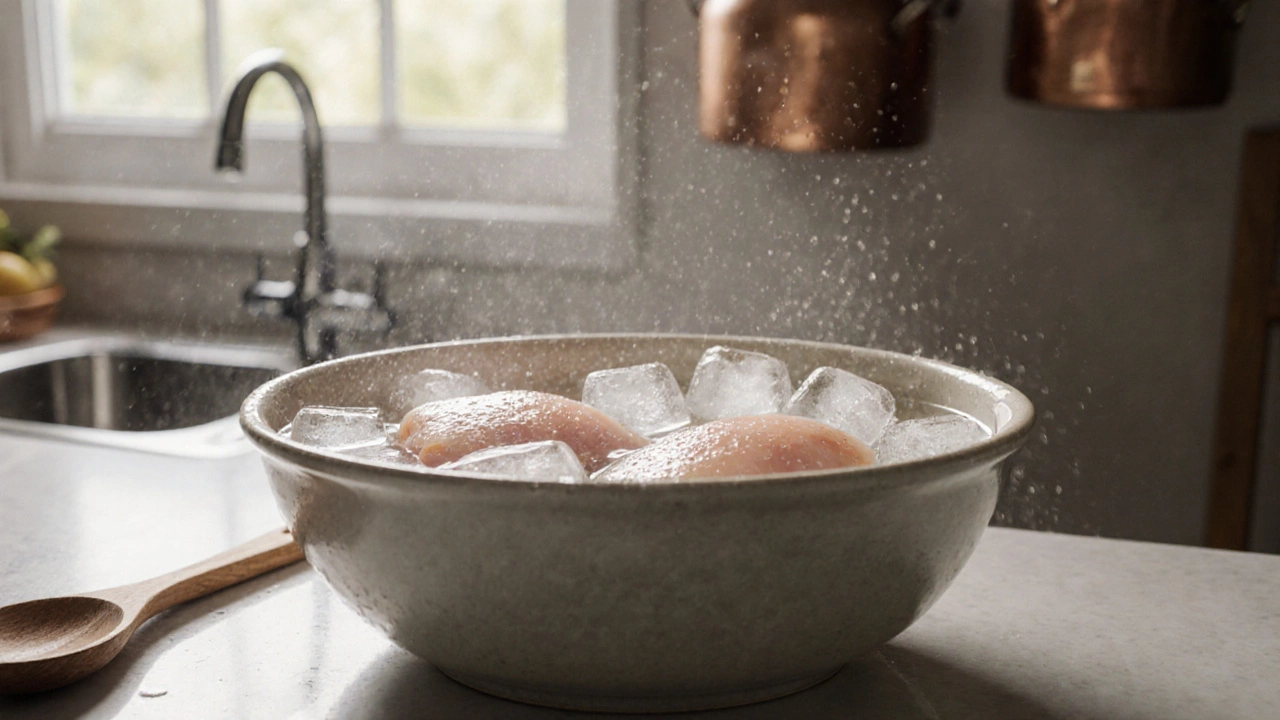Chicken Brine Calculator
Brine Calculator
Your Brine Solution
Pro Tip: For best results, use 1 tablespoon of salt per cup of water. Don't brine longer than 8 hours or chicken becomes mushy.
Nothing ruins a good chicken dish faster than dry, chewy meat. You follow the recipe, you even marinated it, but when you bite into it, it’s like chewing on a rubber band. That’s not how chicken should taste. The good news? Making chicken soft and tender isn’t magic. It’s science-and a few simple tricks you can start using today.
Why Chicken Goes Tough
Chicken breast is lean. That means it has almost no fat to keep it moist while cooking. When it hits 165°F (74°C), the proteins tighten up and squeeze out all the juice. That’s when dryness sets in. Overcooking is the #1 reason chicken turns tough. But even if you cook it to the right temperature, how you prepare it before cooking matters just as much.
Some people think brining is only for turkeys. Nope. A simple saltwater soak can make a huge difference. A 30-minute brine with 1 tablespoon of salt per cup of water lets the muscle fibers absorb extra moisture. That water stays locked in during cooking, so your chicken stays juicy even if you accidentally leave it on the heat a little too long.
Brining: The Secret Weapon
Brining isn’t complicated. Mix 1 cup of cold water with 1 tablespoon of table salt. Stir until the salt dissolves. Add your chicken pieces-breasts, thighs, or drumsticks-and let them sit in the fridge for at least 30 minutes. For thicker cuts like whole breasts, go up to 4 hours. Don’t go longer than 8 hours, or the texture starts to turn mushy.
You don’t need fancy ingredients. Sugar? Optional. Garlic, herbs, or peppercorns? Great additions, but not required. The salt is the star. It changes the protein structure so it holds onto water better. After brining, pat the chicken dry before cooking. Wet chicken won’t brown properly.
Marinating for Flavor and Tenderness
Marinating does more than add flavor. Acidic ingredients like lemon juice, vinegar, or yogurt help break down tough muscle fibers. But here’s the catch: too much acid, or too long, and the meat turns grainy and mushy.
Yogurt is the best marinade base for tender chicken. It’s mildly acidic but also contains enzymes that gently break down proteins without destroying texture. Mix plain full-fat yogurt with a little garlic, paprika, cumin, and a pinch of salt. Coat your chicken and let it sit for 2 to 4 hours in the fridge. Overnight is fine too-yogurt won’t ruin the meat like vinegar might.
Buttermilk works the same way. It’s what Southern fried chicken restaurants use to get that melt-in-your-mouth texture. If you’ve ever wondered why their chicken tastes different, now you know.

Physical Tenderizing: Pound It Out
Chicken breasts are often uneven-thick in the middle, thin at the edges. That’s why the edges dry out before the center is done. The fix? Pound them.
Place the chicken breast between two sheets of plastic wrap or parchment paper. Use a rolling pin, a heavy skillet, or even a wine bottle. Gently pound until the meat is an even ½-inch thickness all over. This does two things: it speeds up cooking time (so less chance of overcooking) and it breaks up the muscle fibers so the meat stays tender.
Don’t go crazy. You’re not trying to turn it into chicken cutlets. Just even it out. You’ll notice the difference the first time you cook it.
Cooking Method Matters
How you cook chicken is just as important as how you prep it. Grilling? Roasting? Pan-searing? Each method needs a different approach.
For pan-seared chicken breasts: Heat a heavy skillet (cast iron is perfect) over medium-high heat. Add a tablespoon of oil. When it shimmers, add the chicken. Don’t move it for 5-6 minutes. Let it form a golden crust. Flip once. Reduce heat to medium-low. Cover the pan. Let it cook gently for another 8-10 minutes. The lid traps steam, which helps cook the inside without drying out the outside.
For oven-roasted chicken: Start it at 425°F (220°C) for 15 minutes to brown the surface, then lower to 350°F (175°C) to finish cooking. This gives you crispy skin and juicy meat. Use a meat thermometer. Pull it out at 160°F (71°C). Carryover heat will raise it to 165°F. That’s the sweet spot.
Thighs and drumsticks? They’re forgiving. Cook them low and slow. Even if you go past 165°F, they stay juicy because they have more fat and connective tissue. Braising them in a little broth or tomato sauce for 45 minutes? That’s when they fall off the bone.
Resting Is Non-Negotiable
Here’s the step most people skip-and it’s the one that turns good chicken into great chicken. After cooking, let the chicken rest for 5 to 10 minutes before cutting into it.
When you pull chicken off the heat, the juices are still moving. If you slice it right away, all that liquid spills out onto the plate. Rest it, and the juices redistribute evenly through the meat. Cover it loosely with foil. It doesn’t need to be wrapped tight. Just enough to keep it warm.
Try this: Cook two chicken breasts the same way. Cut one right away. Let the other rest for 10 minutes. You’ll see the difference in moisture. One looks dry. The other looks juicy. That’s resting.

What Not to Do
Don’t boil chicken. It’s a common mistake. Boiling turns the meat stringy and rubbery. Simmering in broth is fine, but boiling? No.
Don’t microwave it to reheat. Microwaves blast water out of food. Reheat chicken gently in a covered pan with a splash of broth or water. Or better yet, eat it cold in salads or wraps-it’s still tender if it was cooked right the first time.
Don’t use frozen chicken straight from the freezer. Thaw it in the fridge overnight. Cooking frozen chicken leads to uneven cooking and dry spots.
Quick Recap: The 5-Step Formula
- Brine for 30 minutes to 4 hours (1 tbsp salt per cup water)
- Marinate in yogurt or buttermilk for 2-8 hours (optional but powerful)
- Pound thick breasts to even thickness
- Cook to 160°F, then rest off the heat
- Rest for 5-10 minutes before slicing
Follow these steps, and you’ll never serve dry chicken again. It’s not about fancy tools or expensive ingredients. It’s about timing, temperature, and technique.
Real-Life Example: Sunday Dinner Success
Last week, I cooked chicken for a family dinner. I took four boneless, skinless breasts. I brined them for 2 hours. Then I rubbed them with yogurt, garlic, and smoked paprika. I pounded them to even thickness. I seared them in a cast iron pan, covered it, and let them cook gently. I pulled them at 160°F. Let them rest under foil while I made the sides. When I sliced into them, the juices ran clear-not pink, not dry. My 8-year-old said, ‘This tastes like restaurant chicken.’ That’s the goal.
Can I use apple cider vinegar to tenderize chicken?
Yes, but use it carefully. Apple cider vinegar is acidic and will break down proteins, but too much or too long-more than 2 hours-can make the chicken mushy. Mix 1 part vinegar with 3 parts water or yogurt to balance it. Better yet, use yogurt or buttermilk for consistent results without risking texture.
Does marinating overnight make chicken more tender?
For yogurt or buttermilk marinades, yes. Overnight works great. For vinegar or citrus-based marinades, no. After 4 hours, the acid starts to break down the meat too much, making it grainy. Stick to 2-4 hours for acidic marinades. If you want to marinate longer, use yogurt.
Should I remove the skin before cooking?
Leave it on if you can. Chicken skin holds in moisture and adds flavor. You can remove it after cooking if you’re watching fat intake. Skin-on chicken stays juicier, especially when roasted or grilled. Skinless works too, but you’ll need to be more careful with cooking time and moisture tricks like brining.
What’s the best cut of chicken for tenderness?
Chicken thighs and drumsticks are naturally more tender because they have more fat and connective tissue. They’re forgiving even if you overcook them a bit. Boneless, skinless breasts are lean and dry out fast-but with brining, pounding, and resting, they can be just as tender. For absolute ease, go with thighs.
Can I make chicken tender without brining?
Yes, but you’ll need to compensate. Use yogurt or buttermilk marinade, pound the meat, cook it slowly, and rest it well. Brining is the easiest way to guarantee moisture, but if you skip it, the other steps become even more important. Don’t skip resting-that’s non-negotiable.

